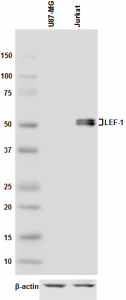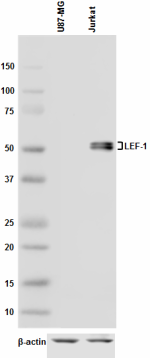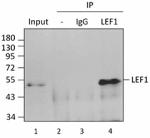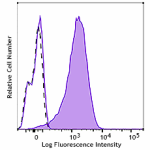- Clone
- 15H5A18 (See other available formats)
- Regulatory Status
- RUO
- Other Names
- Lymphoid enhancer-binding factor 1, T cell-specific transcription factor 1-alpha (TCF1-alpha)
- Isotype
- Mouse IgG1, κ
- Ave. Rating
- Submit a Review
- Product Citations
- publications

-

Total lysates (15 µg protein) from U87-MG (Low expression negative control) and Jurkat (Positive control) cells were resolved by electrophoresis (4-20% Tris-glycine gel), transferred to nitrocellulose, and probed with 1:500 (1 µg/mL) purified anti-LEF1 (clone 15H5A18). Proteins were visualized using chemiluminescence detection by incubation with HRP goat anti-mouse secondary antibody (Cat. No. 405306, 1:3000 dilution). Direct-Blot™ HRP anti-β-actin antibody was used as a loading control (Cat. No. 643807, 1:8000 dilution). -

Immunoprecipitation of LEF1 from Jurkat cell extracts. Lane 1 is 5% input. Immunoprecipitation was performed using protein G resins only (lane 2), mouse IgG isotype control (lane 3), and anti-LEF1 antibody (clone 15H5A18, lane 4). Western blot was performed using anti-LEF1 antibody (clone 15H5A18). -

Jurkat cells (positive control, filled histogram) and Daudi cells (negative control, open histogram) were fixed with Fixation Buffer (Cat. No. 420801), permeabilized using True-Phos™ Perm Buffer (Cat. No. 425401), and intracellularly stained with purified anti-LEF1 (clone 15H5A18), or purified mouse IgG1, κ isotype control (Cat. No. 401402) (open histogram, dashed line) followed by PE goat anti-mouse IgG (Cat. No. 405307).
| Cat # | Size | Price | Quantity Check Availability | Save | ||
|---|---|---|---|---|---|---|
| 653101 | 25 µg | 101 CHF | ||||
| 653102 | 100 µg | 253 CHF | ||||
Lymphoid Enhancing Factor 1 (LEF1) is a transcription factor belonging to the TCF/LEF family. LEF1 was first identified as a protein binding to TCR-α enhancer and upregulates expression of T-cell antigen receptor α chain. LEF1 is involved in Wnt signaling pathways as a ubiquitous regulator. During Wnt signaling, translocation of β-catenin from the cytosol to the nucleus results in elevation of transcriptional activity of LEF1, which subsequently regulates multiple downstream genes.
Product DetailsProduct Details
- Verified Reactivity
- Human
- Antibody Type
- Monoclonal
- Host Species
- Mouse
- Immunogen
- Partial human LEF1 recombinant protein (1-298 aa)
- Formulation
-
This antibody is provided in phosphate-buffered solution, pH 7.2, containing 0.09% sodium azide.
Previous lots of this product may have been formulated with 0.1% or 0.05% NaN3 instead of 0.09% NaN3. For further information please contact BioLegend Technical Support or Customer Service. - Concentration
- 0.5 mg/mL
- Storage & Handling
- Upon receipt, store undiluted between 2°C and 8°C.
- Application
-
WB - Quality tested
IP, ICFC - Verified - Recommended Usage
-
Each lot of this antibody is quality control tested by Western blotting. For Western blotting, the suggested use of this reagent is 0.1 - 1.0 µg per mL (1:5000 - 1:500). For immunoprecipitation, the suggested use of this reagent is 5 - 20 μg per mL. For intracellular flow cytometric staining, the suggested use of this reagent is ≤ 0.125 µg per million cells in 100 µL volume. It is recommended that the reagent be titrated for optimal performance for each application.
- Application Notes
-
LEF-1 is known to have 7 isoforms.
IHC-P (Immunohistochemistry FFPE) is not suggested for this product.
For ICFC (intracellular flowcytometry), True-Phos™ Perm Buffer (Cat. No. 425401) is suggested for permeabilization. - Product Citations
-
- RRID
-
AB_2561614 (BioLegend Cat. No. 653101)
AB_2561614 (BioLegend Cat. No. 653102)
Antigen Details
- Structure
- 44 kD protein containing a DNA-binding domain (HMG box), an CTNNB1-binding region, and a Prolin-rich domain
- Distribution
-
Nucleus
- Function
- LEF1 is a transcription factor mediating canonical Wnt signaling pathway. It has been shown to function in hair bud formation, cancer development, tumorigenesis, angiogenesis, and T-cell maturation.
- Interaction
- Interacts with ALX4, AML-1, beta-catenin (CTNNB1), EP300, MITF, PIAS4, SMAD2, and SMAD3
- Biology Area
- Angiogenesis, Cell Biology, Immunology, Signal Transduction, Transcription Factors
- Molecular Family
- Nuclear Markers, TCRs
- Antigen References
-
- Mallory MJ, et al. 2011. Mol. Cell. Biol. 31:2184.
- Waterman ML, et al. 1991. Genes Dev. 5:656.
- Hovanes K, et al. 2001. Nat Genet. 28:53.
- Bruhn L, et al. 1997. Genes Dev. 11:640.
- Nguyen A, et al. 2005. Int. J. Oncol. 27:949.
- Petropoulos K, et al. 2008. J. Exp. Med. 205:515.
- Gene ID
- 51176 View all products for this Gene ID
- UniProt
- View information about LEF1 on UniProt.org
Related Pages & Pathways
Pages
Related FAQs
Other Formats
View All LEF1 Reagents Request Custom Conjugation| Description | Clone | Applications |
|---|---|---|
| Purified anti-LEF1 | 15H5A18 | WB,IP,ICFC |
Compare Data Across All Formats
This data display is provided for general comparisons between formats.
Your actual data may vary due to variations in samples, target cells, instruments and their settings, staining conditions, and other factors.
If you need assistance with selecting the best format contact our expert technical support team.

 Login / Register
Login / Register 










Follow Us